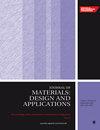A comparative investigation on the surface characteristics of AISI 304 and AISI 1045 steel influenced by turning combined with ball burnishing
IF 2.2
4区 材料科学
Q3 MATERIALS SCIENCE, MULTIDISCIPLINARY
Proceedings of the Institution of Mechanical Engineers, Part L: Journal of Materials: Design and Applications
Pub Date : 2024-07-23
DOI:10.1177/14644207241263793
引用次数: 0
Abstract
Burnishing is a popular superfinishing procedure in the manufacturing industry that induces plastic deformation to the finished product by the application of a highly polished and hardened deforming element known as a burnishing tool. Research work on the burnishing process is numerous. However, the reports containing the comparative investigations are lacking. In this work, the effect of ball burnishing parameters namely penetration depth, burnishing spindle speed, and number of passes has been compared and analyzed on AISI 1045 and AISI 304 steels with respect to surface roughness, hardness, wear resistance, and corrosion resistance. Results indicate that the combination of a feed rate of 0.12 mm/rev, spindle speed of 160 rpm, and penetration depth of 0.025 mm with four passes generated minimum surface roughness (AISI 1045). However, maximum surface hardness is obtained with a feed rate of 0.12 mm/rev, spindle speed of 160 rpm, and at 0.085 mm penetration depth under one pass (AISI 304). The lowest specific wear rate is achieved with a feed rate of 0.12 mm/rev at a spindle speed of 160 rpm and a penetration depth of 0.085 mm in one pass (AISI 304). The burnishing process influenced both materials, AISI 304 and AISI 1045, under varying parametric conditions. The maximum reduction in surface roughness is 68.1% for AISI 304 and 79.3% for AISI 1045, while surface hardness improves by 27% for AISI 304 and 22% for AISI 1045. Additionally, the burnishing process reduces the specific wear rate by 49.3% for AISI 304 and 45.4% for AISI 1045. The refinement of grains during the burnishing process enhances corrosion resistance compared to the unburnished surface.车削结合球形抛光对 AISI 304 和 AISI 1045 钢表面特性影响的比较研究
烧毛是制造业中一种常用的超精加工工艺,通过使用被称为烧毛工具的高度抛光和硬化的变形元件,诱导成品产生塑性变形。有关抛光工艺的研究工作不胜枚举。然而,包含对比研究的报告却很缺乏。在这项工作中,对 AISI 1045 和 AISI 304 钢的表面粗糙度、硬度、耐磨性和耐腐蚀性进行了比较,并分析了球形抛光参数(即穿透深度、抛光主轴速度和抛光次数)的影响。结果表明,进给速率为 0.12 mm/rev、主轴转速为 160 rpm、切入深度为 0.025 mm、切削四次的组合产生的表面粗糙度最小(AISI 1045)。然而,在进给速度为 0.12 mm/rev、主轴转速为 160 rpm、切入深度为 0.085 mm 的情况下,通过一次切削可获得最大的表面硬度(AISI 304)。进给速度为 0.12 mm/rev、主轴转速为 160 rpm、一次切入深度为 0.085 mm 时,特定磨损率最低(AISI 304)。在不同的参数条件下,抛光工艺对两种材料(AISI 304 和 AISI 1045)都产生了影响。AISI 304 和 AISI 1045 的表面粗糙度最大分别降低了 68.1%和 79.3%,而表面硬度分别提高了 27% 和 22%。此外,对于 AISI 304 和 AISI 1045 来说,烧结工艺分别降低了 49.3% 和 45.4% 的特定磨损率。与未烧结表面相比,烧结过程中晶粒的细化提高了耐腐蚀性。
本文章由计算机程序翻译,如有差异,请以英文原文为准。
求助全文
约1分钟内获得全文
求助全文
来源期刊

CiteScore
4.70
自引率
8.30%
发文量
166
审稿时长
3 months
期刊介绍:
The Journal of Materials: Design and Applications covers the usage and design of materials for application in an engineering context. The materials covered include metals, ceramics, and composites, as well as engineering polymers.
"The Journal of Materials Design and Applications is dedicated to publishing papers of the highest quality, in a timely fashion, covering a variety of important areas in materials technology. The Journal''s publishers have a wealth of publishing expertise and ensure that authors are given exemplary service. Every attention is given to publishing the papers as quickly as possible. The Journal has an excellent international reputation, with a corresponding international Editorial Board from a large number of different materials areas and disciplines advising the Editor." Professor Bill Banks - University of Strathclyde, UK
This journal is a member of the Committee on Publication Ethics (COPE).
 求助内容:
求助内容: 应助结果提醒方式:
应助结果提醒方式:


